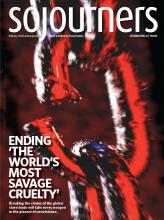One of the highlights of the fall for me was undertaking a kind of Occupy tourism. I was spending most of my time on the move, working to build the broad coalition that eventually won at least a temporary victory against the proposed Keystone XL pipeline from the tar sands of Alberta. In almost every city I visited, I tried to stop by the local encampment, in part because Occupiers were among our most reliable allies, and in part because it was so much fun.
I’ve gotten to speak through the human microphone in lower Manhattan and tour the D.C. campsite just a few blocks from the White House. But I’ve also gotten to sign the copies of my books in the library tent at Occupy Boston (a quiet tent, staffed by honest-to-God librarians from Boston Public Library, with everything arranged by subject). I even made it to foreign occupations—standing beneath a giant stone lion in the grand Vancouver encampment. Happiest occupation goes to San Luis Obispo, California, where I got a hug from a fellow with a huge “Free Hugs” sign. The most chic, not surprising, was Santa Fe, New Mexico, where they arranged not only a campfire for my talk, but a rising full moon in the desert sky.
There are many things they seemed to hold in common, not least an instinctive nonviolence, contrasting so sharply with the police, who so often let the logic of force drive their actions (and found out, as often in history, that the logic that works with criminals doesn’t really apply to idealists). And there was also an instinctive kindness and openness. Many of the encampments, for instance, had attracted homeless people. Since I used to run a homeless shelter in the basement of my church, and in fact lived for a period of time as a homeless man on the streets of New York, I was struck by what a good place to be homeless these camps were. They offered food, safe companionship, and also a kind of purpose, the thing most lacking in the hard and aimless life of the vagrant.
Read the Full Article
